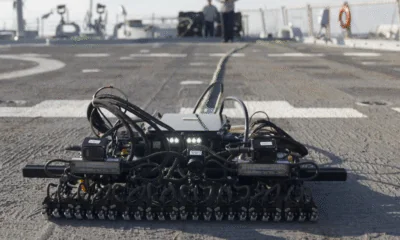Energy
Lasers Are Set to Play a Pivotal Role in Coming Decades as Technology Advances

Laser, short for Light Amplification by Stimulated Emission of Radiation, is a device that emits light at particular wavelengths and amplifies that light to produce a very narrow, very bright beam of radiation focused on a tiny spot. There are many types of lasers, including fiber lasers, gas lasers, solid-state lasers, dye lasers, and diode lasers, all of which share a basic set of components.
Today, lasers are a key part of many of the products that we use every day, from consumer products like Blu-Ray, CDs, DVD players, and barcode scanners to laser printers and LASIK eye surgery. It is further used to measure, cut, engrave, drill, and mark a broad range of materials.
The first laser was developed in 1960, based on Albert Einstein's work on stimulated emission, which led to him receiving the 1921 Nobel Prize. Since then, the global laser technology market has grown significantly and is forecast to reach a value of $25.6 billion by 2027.
Application of Laser Technology
Laser has proved to be an extremely practical tool thanks to delivering monochromatic, controlled, and precisely directed light beams. Much of its important modern-day applications lie in fiber-optic communication, laser machining and fabrication, trace element detection, laser metrology, and medical imaging.
While the science of light itself hasn't changed, laser technology has advanced rapidly over the years. So, while invented decades ago, advancing technology has finally allowed lasers to begin playing the role we have always envisioned for them.
Now, let's take a look at the latest advances and all that is being made possible by this technology in various industries!
Communication
By enabling the creation of secure networks that can transmit vast amounts of data at great speed, greater efficiency, and improved security, laser technology is emerging as a game-changer in satellite communications. As a result, the global space-based laser communication market is expected to quadruple by 2031, as per Straits Research.
In this space, Laser offers a wide array of applications like inter-satellite communications and satellite-to-ground connectivity. And as the number of orbiting satellites continues to grow, space-based laser communications are only going to become even more critical in satellite communications systems.
Most recently, NASA conducted the first successful test of its Deep Space Optical Communications (DSOC) system, a next-generation comms link that sends information by laser light. As part of a series of tests NASA is doing to speed up communications in deep space, this one was the most distant laser communication yet. If successful, NASA officials expect astronauts in coming decades to use it as their means of taking ground control.
Despite laser communications facing many challenges, especially in terms of atmospheric, innovative techniques such as adaptive optics, beam steering, and error correction algorithms are being explored to mitigate these effects, which will advance the practical implementation of laser communications.
So, while space has seen the typical use of laser communications, research, development, and investment are happening to increase the practical use of laser communications. Increasing its bandwidth and operating in a variety of atmospheric conditions will expand laser communications' implementation in defense, civil, commercial, and agricultural markets.
In the international community, standardization efforts are also in progress to ensure interoperability and widespread adoption of laser communication systems.
Defense
The military industry is focusing on developing laser weapons for their ease of operation, precision, and the absence of collateral damage. Furthermore, with the widespread acquisition of lethal drones by militaries worldwide, the capabilities of laser weapons have become a focal point for all military forces.
Last year, there were speculations that Russia had become the first country to use laser weapons, the Persevet and Zadira, in combat to burn down enemy drones. The US has also been advancing work on laser-based air defense.
And earlier this year, Lockheed Martin's tactical laser weapon DEIMOS system achieved its “first light” milestone. The US company is also part of Israel's first-of-its-kind laser-based Iron Beam air defense system that is able to shoot down enemy aircraft, rockets, UAVs, and mortars by directing laser beams at it.
As laser systems gain traction, scientists have also found a new way to significantly increase the power of fiber lasers while maintaining their beam quality, making them a future key defense technology against low-cost drones.
This breakthrough involves the potential use of multimode optical fiber to significantly increase the power output of fiber lasers, ranging from 3 to 9 times, without degrading the beam quality. By achieving this, it allows these lasers to effectively focus on distant targets, resulting in extremely high power output. This increased power output enhances the utility of fiber lasers, making them even more valuable for the defense industry.
Another military superpower, China, has also been making major advances in laser weapons, and a few months ago, Chinese military scientists claimed that they had developed a new cooling system that allows high-energy lasers to operate “infinitely” without any build-up of waste heat, a major technical challenge for laser weapon development.
With this, weapons can now generate laser beams for as long as they want without any interruption or degradation in performance. The new system, which uses advanced structures, has the potential to significantly change the face of defense space by increasing range and damage, extending engagement times, and reducing costs.
Click here for the list of best aerospace and defense stocks.
Health
Besides defense, laser technology is also used extensively in healthcare due to its high accuracy, productivity, sustainability, and adaptability. In the sector, tech is being used to develop new prosthetics and tools for healthcare applications, while healthcare equipment manufacturers are using lasers to design and develop new medical equipment conveniently.
Laser usage reduces the workforce and other costs for manufacturing. It can also identify counterfeit goods in clinics and hospitals. Moreover, Surgeons can perform complex surgical procedures easily with lasers.
From ophthalmology, dentistry, and dermatology to urology, laser technology is seeing increasing usage in healthcare, with issues such as heart diseases, glaucoma, tumors, cancers, varicose veins, prostate problems, knee injuries, and kidney stones being treated with it. Laser-based ultrasound systems, meanwhile, provide images of interior body features while having the potential to track disease stages over time.
Besides this, laser technology is also used in noninvasive medical treatments like selective laser trabeculoplasty, photodynamic therapy, tattoo removal, skin rejuvenation, low-level laser therapy, and hair removal. Low-level laser therapy (LLLT), in particular, stands out in dentistry for offering a distinct advantage in terms of safety and patient comfort and not relying on pharmaceutical interventions.
Moreover, ever since the FDA first gave clearance for a laser in a therapeutic application for human use more than two decades ago, laser therapy and its therapeutic applications have evolved greatly and are prominently used for pain relief, tissue regeneration, and the promotion of general wellness.
Then, there is the use of lasers to prevent mosquitoes from biting humans and spreading disease. Products like the Photonic Fence Monitoring Device (PFMD) monitor insects in flight and eliminate those identified as targets by shooting them down with a microburst of laser energy. PFMD's first application is testing the design and effectiveness of vector control measures against harmful insect incursions in agriculture, hospitality, government, military, and residential pest control markets.
Click for the list of the ten best healthcare stocks.
Analysis and Experimentation
Laser technology plays a crucial role in various fields of analysis and experimentation due to its unique properties, precision, and versatility.
In atomic and molecular physics, researchers and scientists are using lasers to slow down and trap atoms at extremely low temperatures. Besides using lasers to control quantum states, its tunable light source helps in studying the energy levels and transitions in atoms and molecules.
Laser cooling, which was first demonstrated 40 years ago and revolutionized atomic physics to be used in studies on quantum information, quantum degenerate gasses, atomic clocks, and tests of fundamental physics, is now being applied to antimatter. The ability to manipulate the motion of antimatter atoms by laser light is expected to provide ground-breaking opportunities for future experiments, such as anti-atomic fountains and the creation of antimatter molecules.
Back in 2021, the ALPHA collaboration at CERN succeeded in cooling down antihydrogen atoms, the simplest form of atomic antimatter, using laser light, which is seen as a “game-changer for spectroscopic and gravitational measurements.”
Meanwhile, research is also being done into particle acceleration based on laser-plasma interaction to understand the universe. Besides understanding the evolution of all living things by understanding the chemical reactions, the capability of such technology also helps in cancer treatment, where it could provide an alternative to conventional X-ray radiotherapy. Particle acceleration technology based on laser-plasma interaction allows very high energies to be achieved over very small distances, potentially leading to very significant gains in terms of volume.
Laser technology is further utilized to produce nanomaterials with distinct chemical and physical characteristics with several laser-based processes developed for nanomaterial manufacturing, such as laser-assisted reduction, laser exfoliation, and laser ablation.
Clean Energy / Nuclear Fusion
The continuing growth of renewable energy worldwide is presenting increasing opportunities for laser processing techniques. In the clean energy industry, laser technology is used in the manufacturing of new equipment for energy generation as well as the decommissioning of power plants at the end of their life.
Besides being utilized in manufacturing, lasers can be used in cladding, which is also known as laser metal deposition, and improve the properties of the surfaces they treat. Microgas turbine components, meanwhile, can benefit from fiber laser cleaning.
When it comes to solar energy, laser-fired contacts are showing promise for improving the efficiency of solar cells and are used in the cutting and marking of semiconductor wafers as well as separating the electrical circuits of the individual cells of large solar panels.
In the future, we might see lasers used to create a new generation of solar panels as well as the production of batteries for storing power generated by renewable sources.
Laser technology is further seen in nuclear fusion. A year ago, the US Secretary of Energy announced a breakthrough in laser-based nuclear fusion in which a research lab produced a tiny sun on Earth. The light source used in this experiment was the biggest laser in the world, which used 192 beamlines to generate pulses. The laser beams produced 54% more energy than what went into it.
This year, the 192 lasers crushed a tiny capsule filled with deuterium and tritium, heavy isotopes of hydrogen, prompting a fusion reaction that produced more energy than the laser beams shined onto the target during the process.
According to Michael Campbell, former director of the laser fusion lab at the University of Rochester, who is now with the University of California:
“Over the next few years, yields of 5 to 10 MJ are very possible.”
But of course, for that, we are going to need high-energy, high-average-power pulsed lasers built as line-replaceable units, which will lead to many new industrial applications.
Click here for the list of best renewable energy stocks.
Companies Focused on Laser Technology
Now, let's take a look at prominent companies that are developing laser or laser-based technology:
#1. Lockheed Martin Corporation (LMT)
The leading defense and aerospace company, which is also involved in nuclear fusion research, has a market cap of $111.74 bln and revenue trailing 12 months (TTM) of $67.68 bln.
Lockheed Martin Corporation (LMT -0.01%)
Trading at $450.4, Lockheed's stock price is down 7.42% this year while offering a dividend yield of 2.80%. The company's EPS (TTM) is 27.38, and P/E (TTM) is 16.45.
Last year, Lockheed delivered a high-energy laser weapon system to the US Defense Department, and this year, the US Army again granted the company a contract to develop an indirect fire protection capability laser prototype.
#2. Coherent, Inc. (COHR)
A leading manufacturer of laser systems for various applications, including communication, materials processing, and medical, Coherent Corp. has a market cap of $5.45 bln.
Coherent, Inc. (COHR +1%)
As of writing, its shares are trading at $36.02, up 2.62% year-to-date (YTD). For the past 12 consecutive months, Coherent reported $4.869 bln in revenue and had EPS (TTM) of -3.01 and P/E (TTM) of -11.96.
#3. IPG Photonics Corporation (IPGP)
The company produces laser solutions that are used in materials processing, medical, and advanced applications. A few months ago, IPG Photonics launched a dual-beam laser with the ‘highest' single-mode core power.
IPG Photonics Corporation (IPGP -0.34%)
Also involved in clean energy research, IPG Photonics' shares are trading at $95.62, with revenue (TTM) reported at $1.32 bln. The company has an EPS (TTM) of 1.82 and a P/E (TTM) of 52.40.
#4. Northrop Grumman Corporation (NOC)
Northrop Grumman is a global aerospace and defense company with a market cap of $70.8 bln. It is also involved in the development of laser systems for defense applications.
In Oct. 2023, the Pentagon's Space Development Agency gave a $732 million contract to Northrop Grumman to build 38 “data transport” satellites as part of the Proliferated Warfighter Space Architecture the agency is building.
Northrop Grumman Corporation (NOC +1.06%)
Currently, Northrop Grumman's shares are trading at $469.58, down 13.9% YTD. The company has a revenue (TTM) of $38.685 bln and offers a dividend yield of 1.59%.
#5. Thermo Fisher Scientific Inc. (TMO)
The company provides analytical instruments, including those based on laser technology and consumables used in medical research, diagnosis of disease, and discovery and production of new drugs.
Thermo Fisher Scientific Inc. (TMO +0.37%)
Thermo Fisher's stock price is down 11.47% this year as it now trades at $487.53. The company has a market cap of $188.36 bln, posted revenue (TTM) of $43.421 bln, and pays a dividend yield of 0.29% while having an EPS (TTM) of 15.27 and P/E (TTM) ratio of 31.93.
Conclusion
As we saw, laser technology has immense potential and is seeing its implementation in various fields. While lasers are already advancing human capability, as research and advancement continue, the breakthroughs will help the technology evolve and become even more powerful. From medical, sensors, energy, and electric vehicles to digitization and quantum, laser technology is poised to transform vast areas of our lives.
Click here to learn all about investing in the five most promising technologies.












